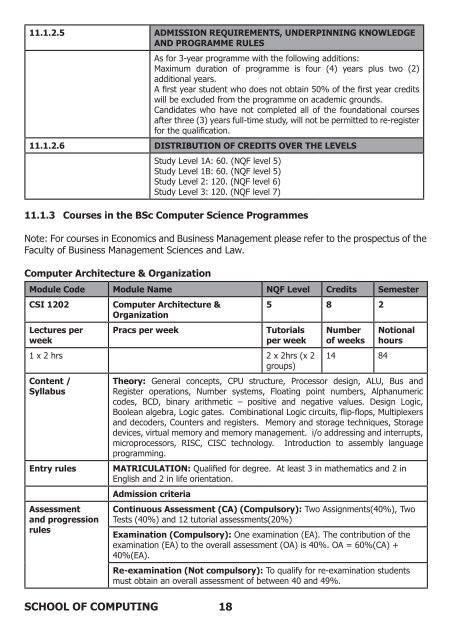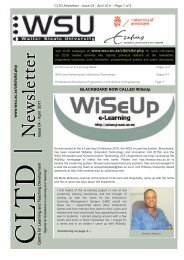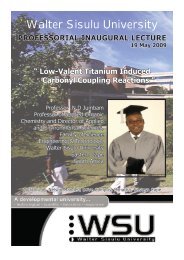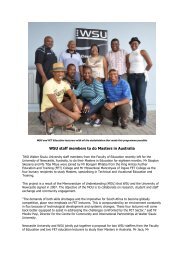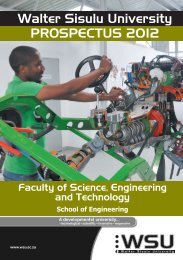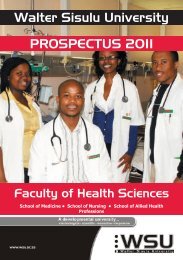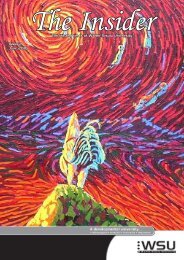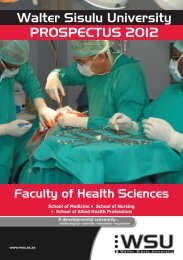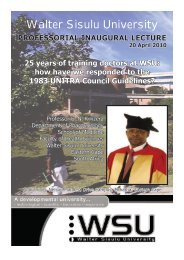School of Computing prospectus 2012 - Walter Sisulu University
School of Computing prospectus 2012 - Walter Sisulu University
School of Computing prospectus 2012 - Walter Sisulu University
Create successful ePaper yourself
Turn your PDF publications into a flip-book with our unique Google optimized e-Paper software.
11.1.2.5 ADMISSION REQUIREMENTS, UNDERPINNING KNOWLEDGE<br />
AND PROGRAMME RULES<br />
As for 3-year programme with the following additions:<br />
Maximum duration <strong>of</strong> programme is four (4) years plus two (2)<br />
additional years.<br />
A first year student who does not obtain 50% <strong>of</strong> the first year credits<br />
will be excluded from the programme on academic grounds.<br />
Candidates who have not completed all <strong>of</strong> the foundational courses<br />
after three (3) years full-time study, will not be permitted to re-register<br />
for the qualification.<br />
11.1.2.6 DISTRIBUTION OF CREDITS OVER THE LEVELS<br />
Study Level 1A: 60. (NQF level 5)<br />
Study Level 1B: 60. (NQF level 5)<br />
Study Level 2: 120. (NQF level 6)<br />
Study Level 3: 120. (NQF level 7)<br />
11.1.3 Courses in the BSc Computer Science Programmes<br />
Note: For courses in Economics and Business Management please refer to the <strong>prospectus</strong> <strong>of</strong> the<br />
Faculty <strong>of</strong> Business Management Sciences and Law.<br />
Computer Architecture & Organization<br />
Module Code Module Name NQF Level Credits Semester<br />
CSI 1202 Computer Architecture &<br />
Organization<br />
Lectures per<br />
week<br />
Pracs per week Tutorials<br />
per week<br />
1 x 2 hrs 2 x 2hrs (x 2<br />
groups)<br />
Content /<br />
Syllabus<br />
18<br />
5 8 2<br />
Number<br />
<strong>of</strong> weeks<br />
14 84<br />
Notional<br />
hours<br />
Theory: General concepts, CPU structure, Processor design, ALU, Bus and<br />
Register operations, Number systems, Floating point numbers, Alphanumeric<br />
codes, BCD, binary arithmetic – positive and negative values. Design Logic,<br />
Boolean algebra, Logic gates. Combinational Logic circuits, flip-flops, Multiplexers<br />
and decoders, Counters and registers. Memory and storage techniques, Storage<br />
devices, virtual memory and memory management. i/o addressing and interrupts,<br />
microprocessors, RISC, CISC technology. Introduction to assembly language<br />
programming.<br />
Entry rules MATRICULATION: Qualified for degree. At least 3 in mathematics and 2 in<br />
English and 2 in life orientation.<br />
Assessment<br />
and progression<br />
rules<br />
Admission criteria<br />
SCHOOL OF COMPUTING<br />
Continuous Assessment (CA) (Compulsory): Two Assignments(40%), Two<br />
Tests (40%) and 12 tutorial assessments(20%)<br />
Examination (Compulsory): One examination (EA). The contribution <strong>of</strong> the<br />
examination (EA) to the overall assessment (OA) is 40%. OA = 60%(CA) +<br />
40%(EA).<br />
Re-examination (Not compulsory): To qualify for re-examination students<br />
must obtain an overall assessment <strong>of</strong> between 40 and 49%.


